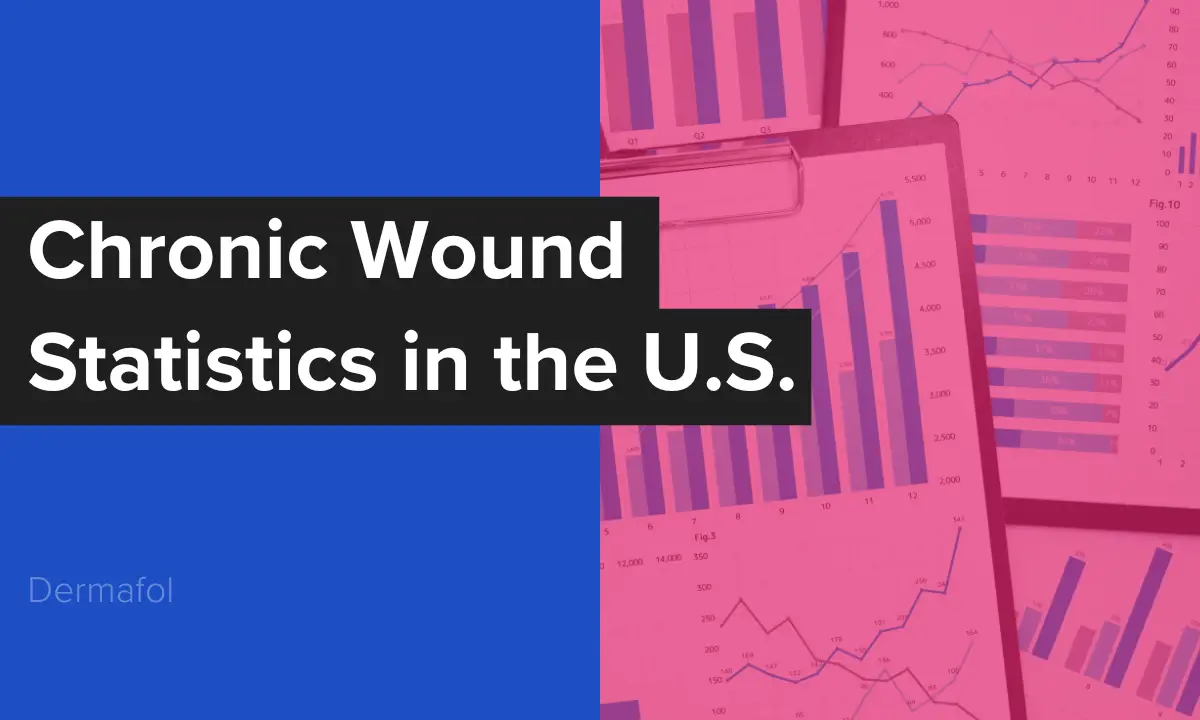Chronic wounds represent a significant public health challenge in the United States, affecting millions of individuals and placing substantial burdens on the healthcare system. These non-healing wounds have profound impacts on patient quality of life, healthcare utilization, and overall mortality.
Here we provide a detailed examination of the epidemiology of chronic wounds in the United States, with specific focus on venous ulcers, pressure ulcers, arterial ulcers, and diabetic foot ulcers.
Overall Burden of Chronic Wounds
Chronic wounds affect approximately 10.5 million Medicare beneficiaries in the United States, representing an increase of 2.3 million from previous estimates17. The impact of chronic wounds extends to nearly 2.5% of the total U.S. population, with this proportion being substantially higher among elderly individuals17. The prevalence of chronic leg ulcers specifically has been reported to affect approximately 1 million Americans, constituting a significant portion of the overall chronic wound burden6. When examining the broader adult population, chronic lower leg ulceration affects about 1% of adults, increasing dramatically to 3.6% among those older than 65 years15.
The increasing prevalence of chronic wounds in the United States can be attributed to several factors, including the aging population, rising rates of diabetes and obesity, and persistent challenges related to infection management. These epidemiological trends suggest that chronic wounds will continue to present substantial clinical, social, and economic challenges in the coming years1. Furthermore, notable disparities exist in the prevalence and management of chronic wounds, with underserved communities and marginalized populations facing greater barriers to accessing quality wound care, which further exacerbates the public health burden17.
Venous Ulcers
Venous leg ulcers represent the most common type of chronic lower extremity wounds in the United States. The prevalence of venous ulcers ranges from 500,000 to 2 million people annually2, with epidemiological studies indicating that approximately 1-3% of the U.S. population is affected8. Venous ulcers constitute the majority (70-90%) of all leg ulcers in the United States611.
The burden of venous disease extends beyond active ulceration, with 10-35% of U.S. adults experiencing chronic venous insufficiency, the underlying condition that leads to venous ulceration810. Among adults aged 65 years or older, approximately 4% have active venous ulcers810. This age-related increase in prevalence reflects the progressive nature of venous insufficiency and the cumulative impact of risk factors such as obesity, reduced mobility, and prior deep venous thrombosis.
Venous ulcers are associated with significant morbidity, prolonged healing times, and high recurrence rates. They typically present with high levels of exudation, malodour, pain, restricted mobility, and sleep disturbance, all of which significantly impact quality of life10. The recurrence rate for venous ulcers is particularly concerning, ranging from 50-70%, which contributes substantially to their chronic nature and ongoing healthcare burden10.
Pressure Ulcers
Pressure ulcers, also known as pressure injuries or bed sores, represent another significant component of the chronic wound burden in the United States. It is estimated that approximately 1 million pressure injuries occur annually in the United States, though definitive epidemiological data remains somewhat limited due to methodological challenges in surveillance and reporting3.
In hospital settings, the reported incidence of pressure injuries ranges widely from 2.7% to 29%, with prevalence estimates varying from 3.5% to 69%3. Patients in critical care units face particularly high risk, with studies documenting a 33% incidence and a 41% prevalence in these settings3. The Fifth National Pressure Ulcer Prevalence Survey, conducted in acute care hospitals, revealed an overall prevalence of 14.8%, with 7.1% of ulcers developing during the current hospitalization period3. Among hospital departments, intensive care units demonstrated the highest prevalence at 21.5%3.
A meta-analysis of pressure ulcer incidence reported a pooled estimate of 12% across various clinical settings9. When examining pressure ulcer staging, first and second stage ulcers each accounted for approximately 45% of cases, while third and fourth stage ulcers represented about 4% each9. The highest incidence was observed among inpatients in orthopedic surgery wards, reaching 18.5%9. Age represents a significant risk factor, with individuals aged 71-80 years constituting the largest single age group (29%) of patients with pressure injuries3.
Notably, pressure ulcers are associated with significant mortality, being listed as the direct cause of death in 7-8% of all patients with paraplegia3. The substantial healthcare impact of pressure ulcers is further highlighted by an estimated 2.5 million hospitalizations in the United States attributable to these wounds9.
Arterial Ulcers
Arterial ulcers, while less prevalent than venous ulcers, represent a significant clinical challenge due to their severity and association with underlying peripheral arterial disease (PAD). Arterial ulcers account for approximately 5-10% of all chronic leg ulcers in the United States414.
The underlying condition, PAD, affects an estimated 5 to 10 million Americans, with many cases remaining undiagnosed until complications such as ulceration develop6. More recent estimates suggest that over 8.5 million individuals in the United States suffer from PAD14. Among individuals aged 60 years or older, arterial ulcers are detected in 18-29% of cases, reflecting the age-related increase in arterial disease6.
Arterial ulcers are associated with several risk factors that increase the likelihood of severe tissue loss and major amputation, including advanced age, male sex, African American ethnicity, and the presence of peripheral neuropathy or infection6. The mortality risk is particularly high for patients with arterial ulcers, with research indicating a hazard ratio of 2.85 compared to matched controls without ulcers, which is higher than the mortality risk associated with other ulcer types13.
Diabetic Foot Ulcers
Diabetic foot ulcers (DFUs) represent a growing epidemiological concern in the United States, driven by the increasing prevalence of diabetes. The pooled global prevalence of DFUs has been reported at 6.3%, with the highest prevalence observed in North America at 13.0%4.
Among individuals with diabetes, approximately 15-25% will develop a foot ulcer during their lifetime, with an annual incidence rate of 2-4%412. For Medicare beneficiaries with diabetes, approximately 8% have a foot ulcer and 1.8% have undergone amputation5. Gender differences exist, with slightly higher prevalence among males (8.2%) compared to females (7.8%)5.
Significant racial and ethnic disparities are evident in the epidemiology of diabetic foot ulcers. The prevalence among Medicare beneficiaries with diabetes varies by race: 8.0% for White Americans, 8.7% for African Americans, 4.2% for Asians, 8.6% for Hispanics, 9.6% for American Indian/Alaska Natives, and 5.5% for other racial groups5. These disparities extend to outcomes, with Native Americans, African Americans, and Hispanics experiencing higher rates of diabetes complications, including amputations, compared to White Americans412.
The severe consequences of diabetic foot ulcers are underscored by amputation statistics. In the United States, diabetic-related non-healing ulcers account for approximately 140,000 extremity amputations each year412. The annual amputation incidence rate ranges from 0.5% to 0.8% per patient-year412. A 10-year study found that the incidence of unilateral lower limb amputation for persons with diabetes ranged from 195 to 197 per 100,000 per year412.
Mixed Etiology Ulcers
While the major categories of chronic wounds are often discussed separately, it is important to recognize that many patients present with ulcers of mixed etiology. Up to 26% of chronic leg ulcers have components of both arterial and venous disease14. These mixed ulcers present particular clinical challenges, as treatment approaches for different ulcer types may be contradictory. For instance, compression therapy, which is standard treatment for venous ulcers, may be contraindicated in the presence of significant arterial disease.
Economic and Social Impact
The economic burden of chronic wounds in the United States is substantial. For venous ulcers alone, annual per-patient health expenditures increase by $6,391 for Medicare patients and $7,030 for those with private health insurance8. Beyond direct healthcare costs, chronic venous disease causes approximately 4.6 million lost workdays annually, with employed individuals with venous ulcers missing an average of four additional workdays per year compared to those without ulcers (representing a 29% increase in work-loss costs)810. In total, chronic venous disease expenditures exceed $1 billion annually in the United States10.
For pressure ulcers, approximately $11 billion is spent annually by the U.S. healthcare system for prevention and treatment9. These direct costs are further compounded by extended hospital stays, increased disability, and reduced productivity.
The social impact of chronic wounds extends beyond economic considerations. Patients with chronic wounds often experience reduced quality of life, pain, limited mobility, sleep disturbance, social isolation, depression, and anxiety10. The need for frequent dressing changes, healthcare visits, and potential hospitalizations disrupts daily life and places significant burdens on both patients and caregivers.
Mortality and Complications
Chronic wounds are associated with increased mortality risk across all major ulcer types. Patients with chronic ulcers demonstrate a 74% higher mortality risk compared to matched controls (hazard ratio 1.74), with the risk being higher in males (HR 1.99) than females (HR 1.62)13. Among underlying causes of death, diabetes was most strongly associated with mortality in chronic ulcer patients (HR 8.98), while sepsis was the immediate cause of death most strongly associated with mortality (HR 5.86)13.
The mortality risk varies by ulcer type, with arterial ulcers carrying the highest risk (HR 2.85), though increased risk is also observed in patients with atypical, mixed, and venous leg ulcers13. These mortality statistics highlight the serious nature of chronic wounds and underscore the importance of effective prevention and management strategies.
Conclusion
The epidemiology of chronic wounds in the United States reveals a substantial and growing public health challenge, particularly given the aging population and rising prevalence of risk factors such as diabetes and obesity. Venous ulcers represent the most common type of chronic leg ulcer, affecting 1-3% of the population. Pressure ulcers remain a significant concern in healthcare settings, with a pooled incidence rate of 12%. Arterial ulcers, while less common, carry the highest mortality risk and are closely associated with peripheral arterial disease. Diabetic foot ulcers affect 8% of diabetic Medicare beneficiaries and lead to approximately 140,000 amputations annually, with significant racial and ethnic disparities in both prevalence and outcomes.
Addressing the public health burden of chronic wounds will require multifaceted approaches including prevention strategies, improved wound care management, and interventions targeting underlying risk factors. Enhanced surveillance systems, standardized reporting methods, and continued research are needed to better understand the epidemiology of chronic wounds and develop more effective interventions. Furthermore, addressing healthcare disparities and improving access to specialized wound care for underserved populations remains a critical priority in reducing the overall burden of chronic wounds in the United States.
References
- https://pubmed.ncbi.nlm.nih.gov/37756368/
- https://effectivehealthcare.ahrq.gov/products/venous-ulcers-treatment/research-protocol
- https://emedicine.medscape.com/article/190115-overview
- https://pmc.ncbi.nlm.nih.gov/articles/PMC10212749/
- https://effectivehealthcare.ahrq.gov/products/diabetes-foot-ulcer-amputation-prevalence/research
- https://evtoday.com/articles/2017-may/ischemic-and-venous-wound-identification-what-we-look-for
- https://www.liebertpub.com/doi/full/10.1089/wound.2023.0150
- https://www.aafp.org/pubs/afp/issues/2019/0901/p298.html
- https://pmc.ncbi.nlm.nih.gov/articles/PMC7716611/
- https://woundsinternational.com/journal-articles/the-impact-of-venous-leg-ulcers-on-a-patients-quality-of-life-considerations-for-dressing-selection/
- https://www.healogics.com/wound-care-patient-information/arterial-venous-ulcers/
- https://nsuworks.nova.edu/cgi/viewcontent.cgi?article=1477&context=hpd_facarticles
- https://www.medicaljournals.se/acta/content/html/10.2340/00015555-3803
- https://provascularmd.com/arterial-ulcer-vs-venous-ulcer/
- https://onlinelibrary.wiley.com/doi/10.1155/2013/413604
- https://diabetesjournals.org/care/article/46/1/209/148198/Etiology-Epidemiology-and-Disparities-in-the
- https://www.tandfonline.com/doi/full/10.1080/13696998.2023.2232256
- https://journals.sagepub.com/doi/10.1177/1358863X211028298
- https://www.ncbi.nlm.nih.gov/books/NBK557868/
- https://www.cdc.gov/mmwr/preview/mmwrhtml/mm5245a3.htm
- https://pubmed.ncbi.nlm.nih.gov/30497932/
- https://pubmed.ncbi.nlm.nih.gov/24625244/
- https://journals.sagepub.com/doi/10.1177/00031348231158691
- https://pmc.ncbi.nlm.nih.gov/articles/PMC1363917/
- https://pmc.ncbi.nlm.nih.gov/articles/PMC9797649/
- https://jamanetwork.com/journals/jamadermatology/fullarticle/477977
- https://emedicine.medscape.com/article/1298345-overview
- https://academic.oup.com/bjs/article/73/9/693/6182126


